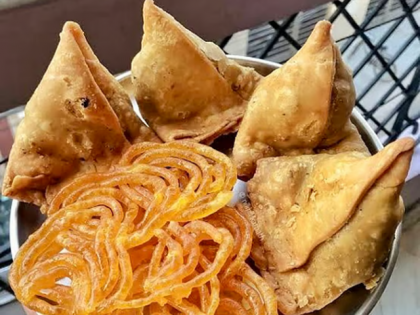Are Samosa and Jalebi Really the True Health Villains? India May Have 449 Million Overweight People by 2050
By Lokmat English Desk | Updated: August 3, 2025 23:12 IST2025-08-03T23:11:04+5:302025-08-03T23:12:15+5:30
In a country where monsoon showers are best enjoyed with a plate of hot samosas and sweet jalebis, a ...

Are Samosa and Jalebi Really the True Health Villains? India May Have 449 Million Overweight People by 2050
In a country where monsoon showers are best enjoyed with a plate of hot samosas and sweet jalebis, a recent directive by the Union Health Ministry has ignited nationwide debate and cultural backlash. The ministry’s effort to promote health awareness — particularly through a suggestion to install “Oil and Sugar Boards” in government cafeterias — has raised the question: are India’s beloved snacks really to blame for the rising health crisis?
The guidelines, issued by the Union Health Secretary last month, advised all ministries and government departments to display the hidden fat and sugar content in popular food items such as samosas, jalebis, vada pav, kachoris, pizzas, and burgers. While the ministry later clarified that its intention wasn’t to target any specific food, the move sparked outrage for what many saw as an assault on India’s street food culture and culinary traditions. The ministry cited growing concerns about obesity and lifestyle-related diseases as the reason behind the initiative. According to a study published in The Lancet, by the year 2050, the number of overweight individuals in India could soar to 449 million. Health officials argue that excessive consumption of oily and sugary foods contributes significantly to this looming crisis.
However, critics argue that the directive oversimplifies a complex issue by equating traditional Indian snacks with ultra-processed, Western-style junk food. The guideline also flagged items like pakoras, gulab jamuns, and banana chips — prompting accusations of cultural insensitivity and a lack of understanding of indigenous food systems.
Experts have pointed out that many traditional Indian dishes are deeply rooted in Ayurvedic principles and often contain ingredients with health benefits. For example, spices like turmeric, cumin, and coriander aid digestion, while group meals foster mental well-being and social bonding. Foods such as dal-baati churma, rasgulla, biryani, and korma carry generations of cultural and medicinal value — aspects that cannot be measured in mere calories.
“This guideline reflects a Western mindset that fails to appreciate the context of Indian diets. It unfairly vilifies time-honored recipes while letting ultra-processed foods — the real culprits — go unchecked,” said one nutritionist.
Social media erupted in criticism, with influencers and health experts questioning the government’s focus. One viral post read: “Ultra-processed foods are the real enemies. What harm have samosa and jalebi ever done to you?”
Critics have also questioned why there is no regulation or warning system for packaged products like chips, sodas, and sugary cereals that flood Indian supermarkets and are heavily marketed to children. Unlike homemade snacks, these factory-made foods undergo chemical processing, contain additives, and are often devoid of nutrition. The controversy highlights a broader issue: the failure of policy makers — many of whom are educated abroad — to understand the realities of the Indian palate and lifestyle. “You can’t apply Western calorie-counting frameworks to Indian food without considering cultural, social, and nutritional nuances,” said a senior food historian.
Rather than stigmatizing cultural foods, experts suggest the focus should be on public education, limiting access to ultra-processed foods, and encouraging balanced, mindful eating. Warning boards, they say, are not the solution. India’s street food culture is not the enemy — it’s the unregulated influx of artificial, mass-produced food products that poses the real threat.
As India prepares to confront a major public health challenge by 2050, perhaps the answer lies not in abandoning our samosas and jalebis, but in reevaluating what health truly means — beyond just fat, sugar, and calories.
Open in app